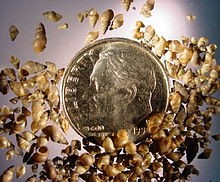
INVASIVE SPECIES | NEW ZEALAND MUD SNAIL
The New Zealand Mud Snail (Potamopyrgus antipodarum) is a species of very small or minute freshwater snail that is considered an invasive species around many parts of the world, where the snail populations can reach phenomenal densities. The species is native to New Zealand and adjacent small islands, generally surviving in the freshwater streams and lakes, but has now rooted itself in many areas including: Australia, Tasmania, Asia, Europe, Canada and the U.S.

The mud snail was first detected in the United States in Idaho’s Snake River in 1987, and has since spread to the Madison River, Firehole River, and other watercourses around Yellowstone National Park, and has continued to move across the United States, spreading into Wyoming, California, Nevada, Oregon, Montana, Colorado, Washington and Michigan. The snail has managed to make it into four out of the five Great Lakes, and was first detected in Lake Ontario in 1991, and by 2005 it had been found widespread in Lake Erie, and by 2008 it had hit Lake Michigan.
The snail tolerates siltation, but thrives in disturbed watersheds, and benefits from high nutrient flows, which allows for filamentous green algae growth. However the mud snail generally prefers the littoral zones in lakes or slow moving streams with silt and organic matter, but is also very capable of burrowing in sediment to survive. In the Great Lakes, the snail can be found at depths of 4-45 meters on silt/sand substrates.

The mud snail has a high reproductive rate and no natural predators or parasites in the United States, and consequently densities have reached greater than 300,000 individuals per meter squared. However in the Great Lakes the snail densities generally only reach 5,600 per meter squared. The mud snail is also extremely resilient. A snail can live up to 24 hours without water, and can survive for up to 50 days on a damp surface, giving them more than plenty of time to be transferred from one body of water to another, from fishing gear, boats, and bait. The snail has even been known to survive passing through digestive systems of fish and birds. This lack of predators and impressive resilience leads to endangerment of the food chain through outcompeting native snails and water insects for food, leading to sharp declines in native snail species. This can cause the fish populations to suffer as the native snails are a main source of food.
In an attempt to slow the spread many agency officials throughout the states have advised the public to keep an eye out for the snails, and that anglers and outdoors enthusiasts should bleach or heat any gear which may contain mud snails. The mud snails in the U.S. grow smaller than in their native habitat, reaching about ¼ of an inch, making it easy to miss them when cleaning fishing gear. In other attempts to slow the snail’s progress, a combination of management strategies including: prevention and physical, chemical and biological control practices. The most important strategy is public awareness, so when you’re out enjoying the Great Lakes and their connecting waters, keep in mind the importance of our native fish and wildlife and don’t transfer boats or gear from one body of water to another without proper cleaning of all your supplies.
This article is part of the ongoing series on invasive species funded in part with funds from the Michigan Invasive Species Grant Program through the Departments of Natural Resources, Environmental Quality, and Agriculture and Rural Development
